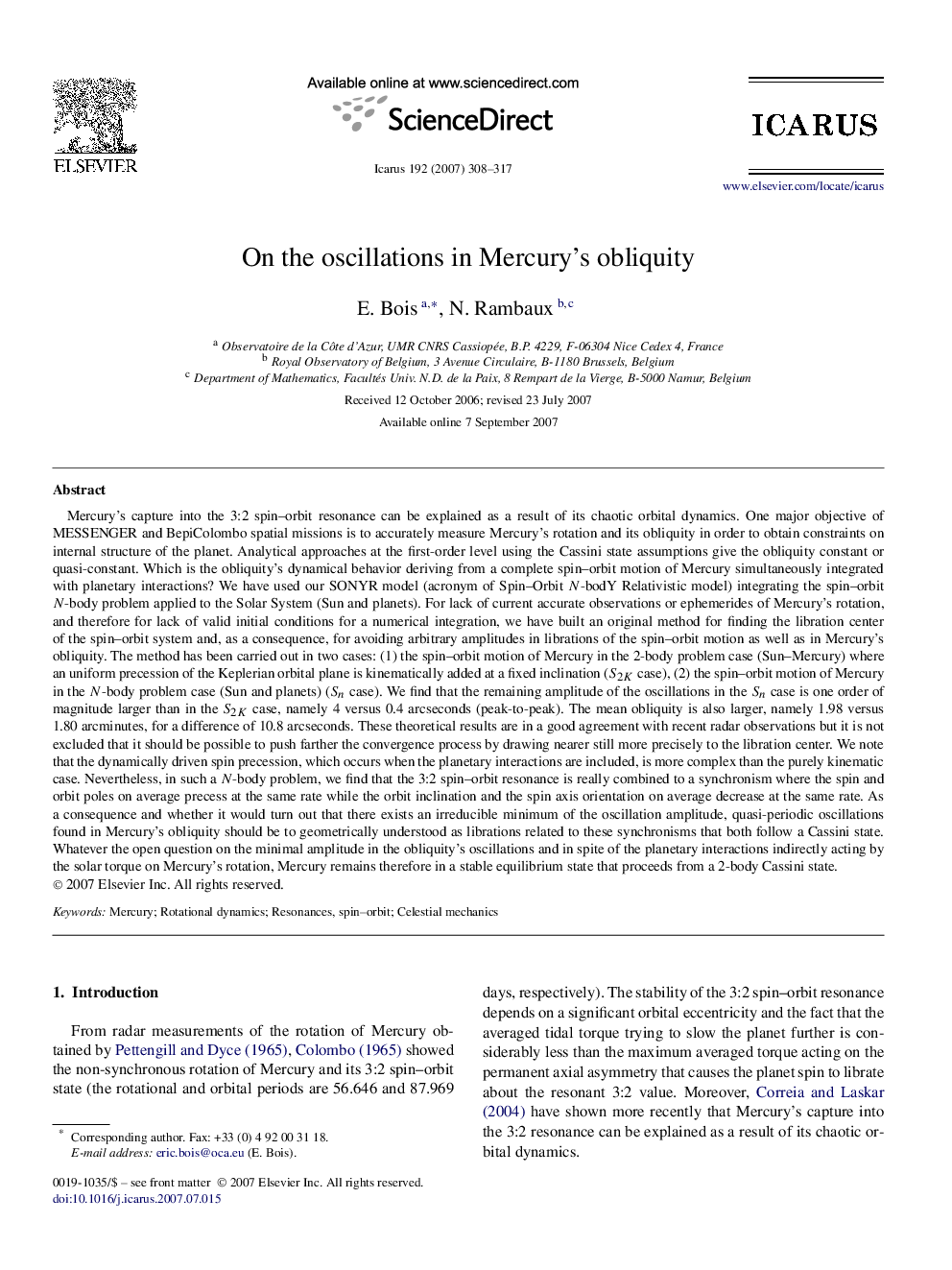| کد مقاله | کد نشریه | سال انتشار | مقاله انگلیسی | نسخه تمام متن |
|---|---|---|---|---|
| 1775905 | 1021211 | 2007 | 10 صفحه PDF | دانلود رایگان |

Mercury's capture into the 3:2 spin–orbit resonance can be explained as a result of its chaotic orbital dynamics. One major objective of MESSENGER and BepiColombo spatial missions is to accurately measure Mercury's rotation and its obliquity in order to obtain constraints on internal structure of the planet. Analytical approaches at the first-order level using the Cassini state assumptions give the obliquity constant or quasi-constant. Which is the obliquity's dynamical behavior deriving from a complete spin–orbit motion of Mercury simultaneously integrated with planetary interactions? We have used our SONYR model (acronym of Spin–Orbit N-bodY Relativistic model) integrating the spin–orbit N -body problem applied to the Solar System (Sun and planets). For lack of current accurate observations or ephemerides of Mercury's rotation, and therefore for lack of valid initial conditions for a numerical integration, we have built an original method for finding the libration center of the spin–orbit system and, as a consequence, for avoiding arbitrary amplitudes in librations of the spin–orbit motion as well as in Mercury's obliquity. The method has been carried out in two cases: (1) the spin–orbit motion of Mercury in the 2-body problem case (Sun–Mercury) where an uniform precession of the Keplerian orbital plane is kinematically added at a fixed inclination (S2KS2K case), (2) the spin–orbit motion of Mercury in the N -body problem case (Sun and planets) (SnSn case). We find that the remaining amplitude of the oscillations in the SnSn case is one order of magnitude larger than in the S2KS2K case, namely 4 versus 0.4 arcseconds (peak-to-peak). The mean obliquity is also larger, namely 1.98 versus 1.80 arcminutes, for a difference of 10.8 arcseconds. These theoretical results are in a good agreement with recent radar observations but it is not excluded that it should be possible to push farther the convergence process by drawing nearer still more precisely to the libration center. We note that the dynamically driven spin precession, which occurs when the planetary interactions are included, is more complex than the purely kinematic case. Nevertheless, in such a N-body problem, we find that the 3:2 spin–orbit resonance is really combined to a synchronism where the spin and orbit poles on average precess at the same rate while the orbit inclination and the spin axis orientation on average decrease at the same rate. As a consequence and whether it would turn out that there exists an irreducible minimum of the oscillation amplitude, quasi-periodic oscillations found in Mercury's obliquity should be to geometrically understood as librations related to these synchronisms that both follow a Cassini state. Whatever the open question on the minimal amplitude in the obliquity's oscillations and in spite of the planetary interactions indirectly acting by the solar torque on Mercury's rotation, Mercury remains therefore in a stable equilibrium state that proceeds from a 2-body Cassini state.
Journal: Icarus - Volume 192, Issue 2, 15 December 2007, Pages 308–317